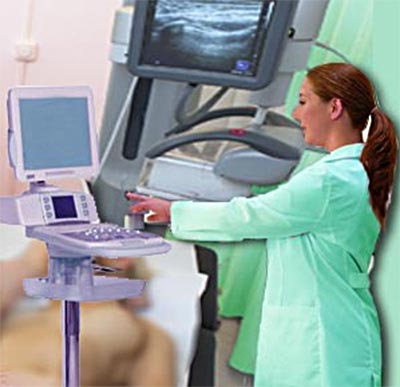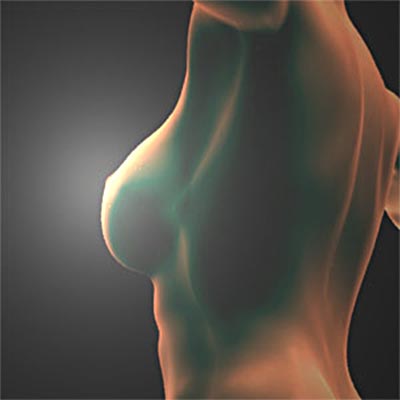Breast Ultrasound

Breast ultrasound involves transmitting high-frequency sound waves to the breast surface and recording the echoing waves. The images so formed indicate the structure of the breast tissue, be it dense tissue, cysts filled with fluid or tumors. Breast ultrasound is not used in regular screenings for breast cancer. It is typically undertaken when breast tissue is very dense or to determine the condition of a suspicious lump that has been noticed on a clinical breast examination or a mammogram. It is a tool to evaluate breast implant leak or rupture.
Breast cancer ultrasound
Breast ultrasound is done by bouncing high frequency sound waves off breast tissue. The resultant echoes are recorded in video or photographic images. Breast ultrasound is useful in gaining clearer insight into determining whether a suspicious lump is a fluid-filled cyst or a solid mass. In breasts with larger amount of glandular tissue and less fat, mammography may not be able to detect breast cancer early.
Breast ultrasound is not routinely considered for breast cancer screening. It is in fact used for investigation, in cases where there is need for clearer imaging after a mammogram. It is also recommended in case a lump is felt on clinical breast exam. Breast ultrasound is non-invasive and does not make use of ionizing radiation. Soft tissues and dense tissues can be better examined with breast ultrasound rather than x-rays. Often benign cysts and fat lobules can be detected during a breast ultrasound.
Just because you have been sent for a breast ultrasound does not mean that you are suffering a cancer. Abnormalities such blocked milk ducts or bloody nipples can be examined clearly with a breast ultrasound. The breast ultrasound is able to capture the blood flow within the breast blood vessels. This helps in determining whether a breast mass has any blood flow within it or not. Blood supply to breast lesions can be accurately assessed with breast Doppler ultrasound.
Women at intermediate to high risk for breast cancer are suggested to go in for breast MRI. Breast ultrasound is also offered for women who have silicone breast implants and lesser breast tissue. Ultrasound may not be able to detect all cancers or calcifications. It is used in conjunction with mammography, not to replace it as a diagnostic tool.
Breast ultrasound is a good tool to investigate breast abnormalities in pregnant women since there is no radiation used. Breast ultrasound study hinges on the skill of the radiologist performing it. The procedure usually takes about 30 to 45 minutes. It does not require any compression of the breast.
Breast ultrasound guided biopsy
Breast ultrasound can aid in locating a tumor and performing a biopsy or aspiration procedure. The needle is guided with the help of the breast ultrasound. Often, a small breast tissue sample or biopsy is taken for diagnosis. Guided by the breast ultrasound, this procedure can be done sans surgery and significant scarring to the breast. The tumor can be quickly and comfortably reached through ultrasound guidance.
The ultrasound of the breast can indicate the extent of cancerous growth into surrounding tissues. The ultrasound-guided breast interventional procedures are cyst aspiration, needle biopsy, fine needle aspiration and needle localization.
Bilateral breast ultrasound
Bilateral breast ultrasound is performed for women with significant family history. If there is a suspected malignancy in one breast, bilateral whole breast ultrasound is performed.
Top of the Page: Breast Ultrasound
Tags:#breast ultrasound #breast ultrasound images #breast cancer ultrasound #abnormal breast ultrasound #bilateral breast ultrasound

Cancer Staging and Grading
Mammogram - Breast Xray
Breast Ultrasound
Breast MRI
Breast Augmentation
More on Breast cancer

Stress and Breast Cancer
Breast Density and Breast Cancer Risk
Lower your Breast Cancer Risk
Breast Cancer Myths
Mastitis
Breast Cancer Awareness
Preventing Breast Cancer
Breast Self Exam
Breast Cancer Chemotherapy Treatment
Palpable Breast Mass
Breast Cyst
Breast Cancer Symptoms
Breast Calcification
Breast Cancer Treatment
Mastectomy
Top of the Page: Breast Ultrasound
Popularity Index: 100,794

